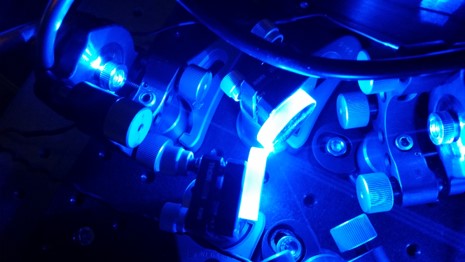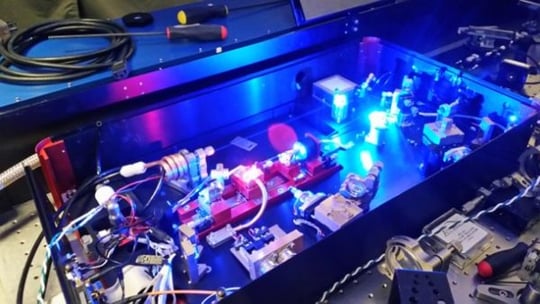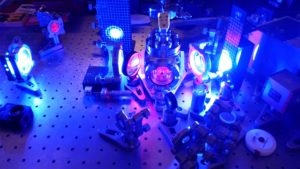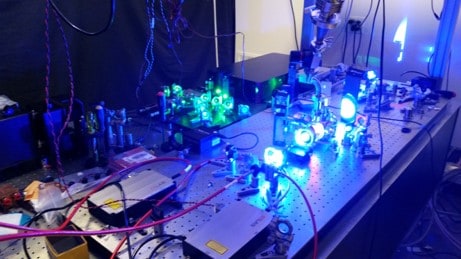Overview: Revolution in Ultrafast: Directly Pumping Ti:sapphire with Laser Diodes
Many scientific and industrial applications can benefit from the use of ultrashort sub-100 fs duration pulses with moderate energy, but at >100 kHz repetition rates. Typically, Ti:sapphire oscillator/amplifier systems have filled this role as a workhorse for research applications, with their unmatched ultrashort-pulse amplification performance and tunability. More recently, Yb-based fiber lasers and other ultrafast sources have become more broadly adopted for less-demanding applications, offering the advantages of a direct diode-pumped architecture at the expense of pulse duration performance, while Ti:sapphire systems require complex intracavity-doubled green lasers for the pump source. Nonlinear pulse compression or parametric amplification pumped by Yb-based lasers can satisfy some needs for ultrafast pulses and tunability, but again increase complexity and reduce the reliability of the source, and often generate pulses with large pedestal and other poor characteristics. Thus, the ideal ultrafast laser—diode pumped, simple, reliable, and with uncompromising performance—has now been realized.
DDPTS Oscillators
Commercial Ti:sapphire laser oscillators have in the past employed a number of pump laser sources, including Argon Ion, intra-cavity doubled Nd:YVO4, frequency-doubled OPSELs, and doubled IR laser diodes. However, for Kerr-Lens Modelocked femtosecond ti:sapphire lasers, it was found very early-on that the mode-matching process that sustains KLM was very sensitive to the mode quality of the pump light. For example, degradation of Argon-ion lasers to a “donut” TEM01+TEM10 mode greatly degraded stability of modelocking.
The surprising success of the KLM process, even for such relatively poorly-focused pump light, can be explained by the fact the mode-matching optimization good power discrimination for the modelocked mode can be obtained when the M2 of the pump light is relaxed in one dimension of the pump and maintained in the other. A typical 400-532 nm laser diode emits in a stripe with M2~1-1.5 in the fast axis, and M2~5-15 in the slow axis. A relatively tight focus in one dimension still allows for better mode-matching when the laser is running ultrashort-pulse (Patents 8,976,821/9,425,581). Furthermore, the asymmetry of the Kerr lens—the pulse cycles back and forth in the cavity, but is short only traveling in one direction—assists with energy extraction. Oscillators producing 200mW, 13fs pulses have been demonstrated.


DDPTS Amplifiers
Scaling to high power requires maintaining sufficient brightness in the pump source, while allowing for a scalable architecture. The gain in a “good” laser material depends primarily on the peak gain cross section and the lifetime of the gain medium. In comparison with diode-pumped Yb laser systems (for example, Yb:KGW sg=3×10-20 cm2; t=600 µsec) the power density required for similar gain in Ti:sapphire (sg=3×10-19 cm2, t=3.9 µsec at low temperature) is approximately 15x higher. Furthermore, Yb materials can be quite heavily-doped (up to 25%), making it possible to focus the pump light tightly and absorb it in a relatively short length in the crystal, before the focal spot diverges. By contrast, doping of Ti3+ in sapphire is limited to ~0.25-0.41% by weight. At higher doping levels, optical quality is degraded and excited-state absorption (ESA) increases loss. In contrast to the very high power >100W diode bars available in the IR, multi-emitter diode bars at 450 nm are not available. Therefore, single emitters, and arrays of single emitters can be used directly, or through multimode fiber coupling.


Example References:
Optics Express “Direct diode-pumped Kerr-lens mode-locked Ti:sapphire laser,” 20 (13), 13677-13683 (2012).
“Direct Diode Pumped Kerr Lens Modelocked Ti:Sapphire Laser Oscillator,” in Conference on Lasers and Electro-Optics 2012, OSA Technical Digest (online) (Optical Society of America, 2012), paper CM2J.2.
Optics Express “Direct diode pumped Ti:sapphire ultrafast regenerative amplifier system,” 25 (4), 3666-3674 (2017).
Optics Express “Direct diode-pumped Kerr Lens 13 fs Ti:sapphire ultrafast oscillator using a single blue laser diode” 25, 12469-12477 (2017)



